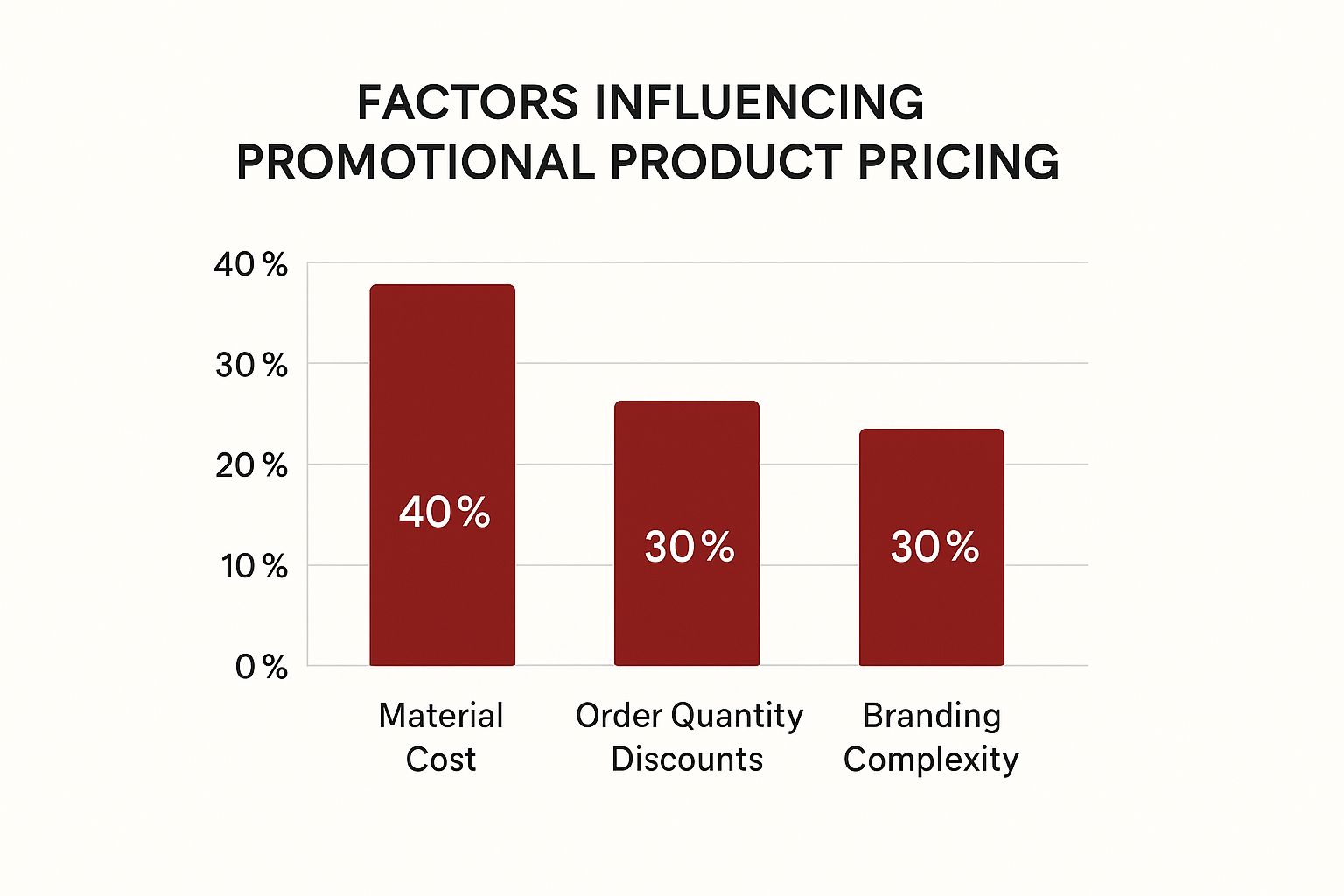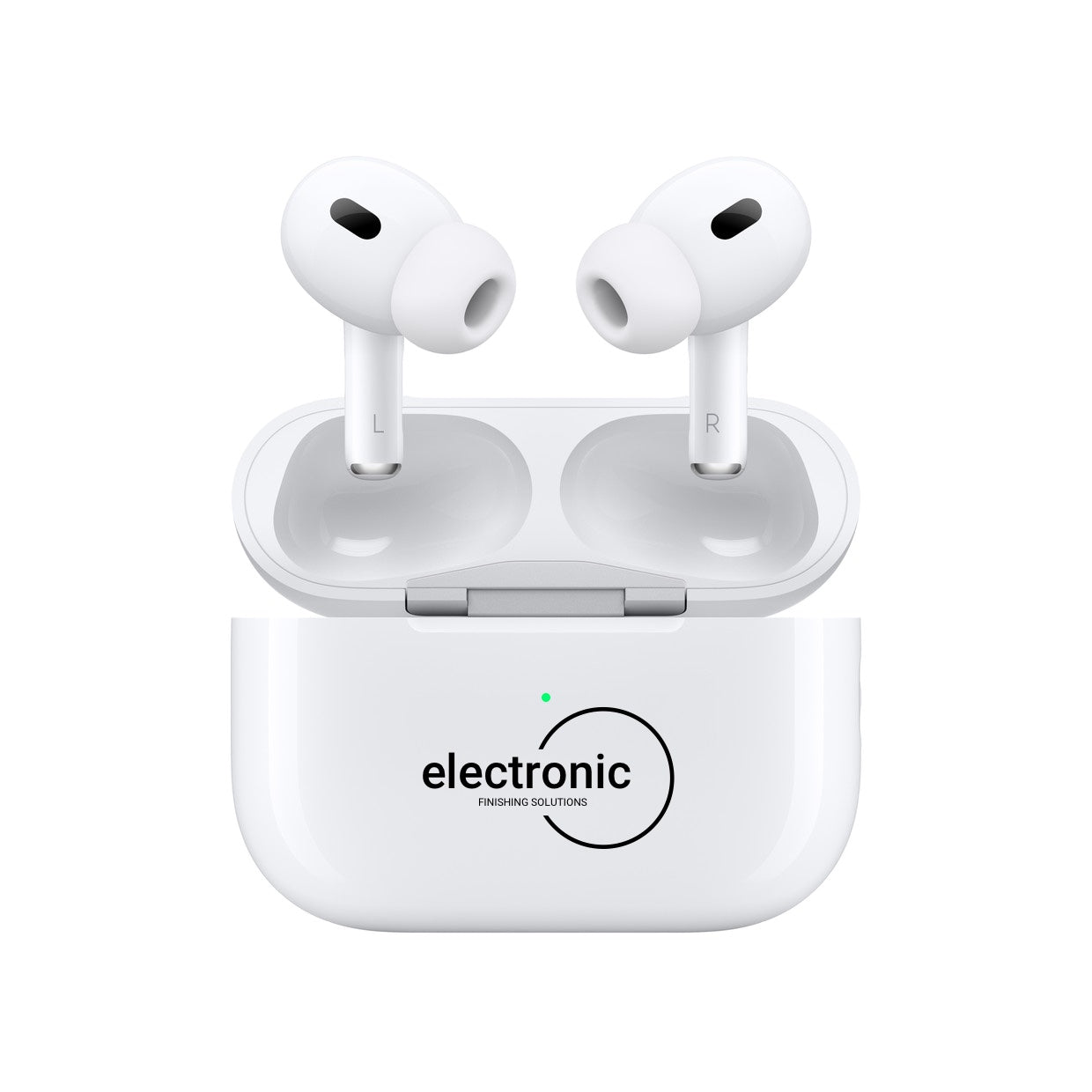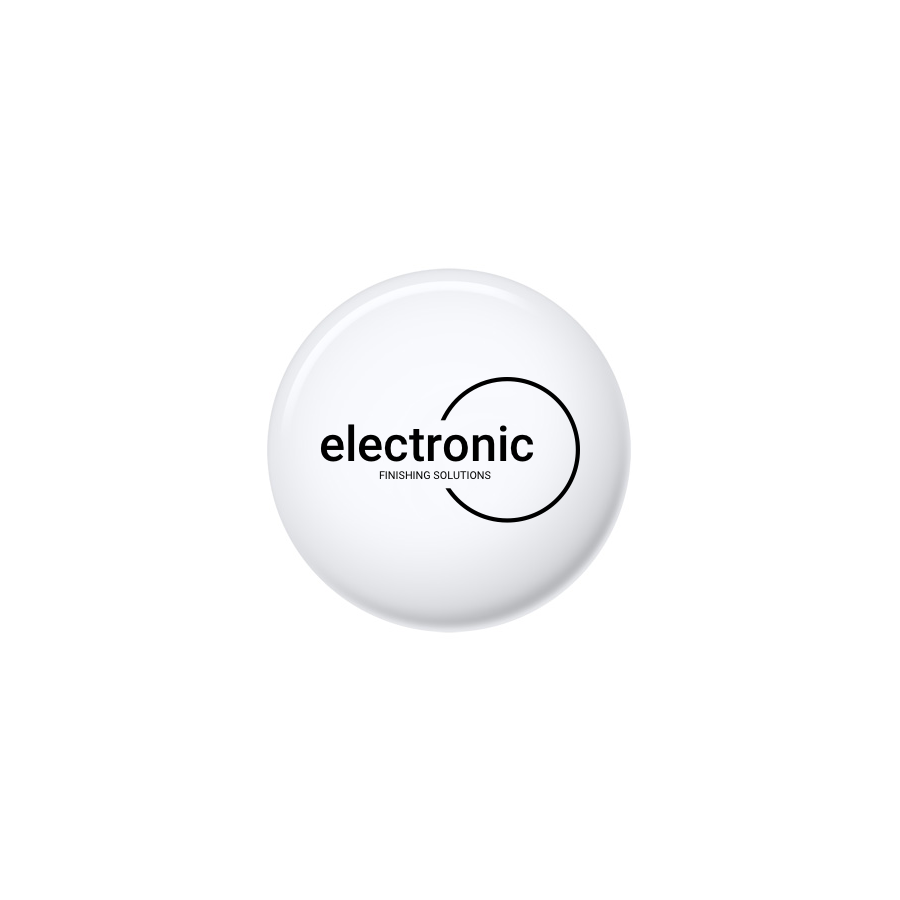Understanding The Promotional Product Pricing Game

Navigating the world of promotional product pricing can feel like a daunting task. The sheer size of the market adds another layer of complexity. The global promotional products market, for example, reached $90.5 billion in 2023.
It's projected to hit $117.1 billion by 2030. This growth highlights the importance of understanding what drives these prices. Find more detailed statistics here
Decoding the Pricing Maze
Promotional product pricing isn't random. It's the result of a complex combination of factors. Understanding these factors helps businesses secure the best possible deals and maximize their return on investment.
-
Perceived Brand Value: The price tag on a promotional product often reflects the perceived value of the brand it represents. Higher-priced items can create an impression of quality and prestige, influencing how customers perceive your business.
-
Market Insights: Smart buyers use market data to keep up with pricing trends. This knowledge allows them to identify fair prices and negotiate effectively with suppliers, preventing overspending.
-
Hidden Costs: The lowest price isn't always the best value. Sometimes, a low price hides hidden costs like subpar materials or unethical manufacturing practices. These can negatively impact your brand image.
Identifying Red Flags and Opportunities
Recognizing pricing red flags protects your business from expensive mistakes. At the same time, spotting opportunities lets you take advantage of favorable market conditions.
-
Unrealistic Discounts: Exceptionally low prices should raise a red flag. They can indicate potential quality issues or hidden costs that require careful consideration.
-
Lack of Transparency: If a supplier is hesitant to share their pricing structure, they may be hiding something. Transparency builds trust and ensures a fair deal.
-
Seasonal Fluctuations: Prices often change based on seasonal demand. Understanding these patterns can lead to significant cost savings, allowing you to strategically plan your purchases.
Understanding what influences promotional product pricing helps businesses navigate this intricate landscape. This knowledge empowers informed decision-making, builds stronger supplier relationships, and ultimately leads to better returns on promotional product investments. This sets the foundation for understanding the underlying cost drivers.
What Really Drives Your Promotional Product Costs

This infographic highlights the key factors affecting promotional product pricing. These factors fall into three main categories: Material Cost, Order Quantity Discounts, and Branding Complexity. The infographic shows material cost makes up the largest share at 40%. Order quantity discounts and branding complexity each contribute 30%. This breakdown reveals that while choosing the right material is important, smart negotiation and order planning can significantly impact your budget.
Unpacking Material Costs
The materials used have a big impact on promotional product pricing. A basic cotton t-shirt, for instance, will have a lower starting price than a technical polyester blend. Ethically sourced or sustainable materials usually come at a premium because of their unique production processes. These differences mean choosing higher quality materials directly increases the cost per item, requiring careful budget allocation.
The Power of Order Quantity
Savvy procurement teams use order quantity discounts to reduce expenses. The principle is similar to buying in bulk: the more you order, the less each unit costs. But this approach needs careful planning to avoid excess inventory. Overstocking ties up resources and can eliminate the savings gained from volume discounts. Finding the sweet spot is key to maximizing your return on investment.
Branding Adds Value (and Cost)
Your branding also plays a role in the final cost. A simple, one-color logo on a pen costs much less than a complex, embroidered design on a backpack. Intricate designs or special packaging will add to the production cost. Balancing brand impact and budget is crucial for successful promotional campaigns.
To help illustrate the cost breakdown across different product categories, let's look at the table below:
Promotional Product Cost Breakdown by Category
Comparison of average pricing ranges across popular promotional product categories including setup fees, unit costs, and quantity discounts
| Product Category | Low-End Price | Mid-Range Price | Premium Price | Setup Fees |
|---|---|---|---|---|
| T-Shirts | $5 - $10 | $10 - $15 | $15+ | $50 - $100 |
| Pens | $0.25 - $0.50 | $0.50 - $1.00 | $1.00+ | $25 - $50 |
| Backpacks | $15 - $25 | $25 - $50 | $50+ | $75 - $150 |
| Drinkware | $2 - $5 | $5 - $10 | $10+ | $50 - $100 |
| USB Drives | $5 - $10 | $10 - $20 | $20+ | $50 - $100 |
This table provides a general overview of promotional product pricing. Keep in mind that actual costs can vary based on material, order quantity, and branding complexity.
Negotiating With Suppliers
Understanding your supplier's costs is vital for effective negotiation. Knowing the breakdown between material, labor, and overhead empowers buyers to secure better rates. Strategic timing, such as purchasing during a supplier's off-season, can also unlock additional savings. This enables you to get better pricing and maximize your promotional product budget.
Regional Market Insights That Impact Your Bottom Line
Promotional product pricing varies significantly across the globe, influenced by regional market dynamics. These differences present both opportunities and challenges for businesses. Understanding these dynamics is key to maximizing your purchasing power and getting the best value.
Geographic Pricing Variations
The price of the same promotional product can change drastically based on its source. For example, a custom-branded power bank may be cheaper to produce in Asia but incur higher shipping costs to North America.
Supplier relationships and local market competition also play a key role in price fluctuations. Choosing suppliers strategically, considering both location and existing relationships, is essential.
You might be interested in: How to master...
Europe currently holds about 30% of the global promotional product market, generating USD 7,954.26 million in 2024. The Asia Pacific region accounts for 23% of the market share and is projected to grow at a 6.0% CAGR between 2024 and 2031. This points to a dynamic pricing environment in the Asia Pacific region. Explore this topic further
Leveraging Regional Advantages
Smart companies leverage regional advantages to optimize promotional product pricing. Some source products from regions with lower labor costs, while others prioritize strong relationships with local suppliers for better negotiation. This strategic sourcing can result in significant cost savings without compromising quality.
Anticipating Pricing Trends
Understanding regional economic factors and market maturity is crucial for anticipating pricing trends. Emerging markets, for instance, might offer lower initial prices, but rapid growth can lead to price increases. Mature markets, on the other hand, may have more stable pricing but less flexibility for negotiation. This knowledge is essential for developing effective long-term procurement strategies.
Practical Tips for Working with Suppliers
- Understand cultural nuances: Effective communication and negotiation strategies differ across regions.
- Consider time zone differences: Plan meetings and communication accordingly.
- Establish clear contracts: Protect your interests with well-defined agreements.
- Build strong relationships: Nurture trust and open communication with your suppliers.
By understanding the influence of regional markets on promotional product pricing, businesses can create a more effective and insightful procurement strategy. This ensures you receive maximum value from your promotional product investments.
Proven Strategies For Maximum Promotional Product ROI
Stop thinking of promotional products as just another expense. Think of them as strategic investments that can significantly boost your business. By understanding promotional product pricing, you can transform these expenses into measurable returns. This involves calculating true campaign costs, evaluating pricing proposals, and building strong supplier relationships.
Calculating True Campaign Costs
Many businesses focus only on the unit cost of promotional products. But this overlooks crucial hidden expenses that can inflate your overall budget. Consider factors like shipping fees, customization charges, and storage costs. Also, factor in the time spent managing the project, an internal cost often missed in budget calculations. Accurately assessing these costs provides a more realistic view of your investment and helps you make informed decisions.
Evaluating Pricing Proposals Like a Pro
Don't just accept the first quote you receive. Compare proposals from multiple suppliers, paying close attention to the details. Look beyond the headline price and consider factors like payment terms, production timelines, and quality guarantees. This lets you compare apples-to-apples and choose the supplier who best meets your needs and budget. Learn more in our article about How to Master High-End Gifting.
Building Supplier Relationships That Pay Off
Strong supplier relationships are essential for long-term success in promotional product pricing. Open communication, clear expectations, and mutual respect build trust and lead to better deals over time. Think of suppliers as partners who can offer valuable insights into market trends and cost-saving opportunities. This collaborative approach helps you stay ahead of the curve and maximize your promotional product ROI.
Aligning Pricing With Marketing Objectives
Promotional product pricing should directly support your overall marketing objectives. If your goal is brand awareness, investing in higher-quality, premium products might make sense. But if your focus is lead generation, a larger quantity of lower-cost items might be more effective. Aligning your promotional product strategy with your marketing goals ensures every dollar spent contributes to your overall business objectives. In 2023, the U.S. promotional products industry generated $26.1 billion, with over half of consumers reporting a more favorable impression of advertisers who give promotional products. Discover more insights about promotional product statistics.
Measuring Success Beyond Cost-Per-Unit
Finally, move beyond simple cost-per-unit calculations when evaluating ROI. Consider the broader impact of your promotional products on brand perception, customer loyalty, and overall sales. Track metrics like website traffic, social media engagement, and lead conversions to fully understand your promotional product effectiveness. This comprehensive approach provides a more accurate picture of your campaign's success and informs future pricing decisions.
Mastering Volume Discounts Without Overcommitting

Promotional product pricing often relies on volume discounts. This means the more items you purchase, the lower the cost per item. However, buying massive quantities isn't always the best strategy. Overbuying can result in surplus inventory and tie up valuable resources. This section explores smart ways to use volume discounts and maximize savings without overstocking.
Calculating Optimal Order Sizes
The secret to leveraging volume discounts lies in determining the optimal order size. This involves balancing the reduced cost from bulk orders against the expense of storing and managing excess inventory.
A careful examination of supplier pricing tiers and break-even points is essential. You need to determine the exact quantity at which a larger order truly becomes more cost-effective than placing multiple smaller orders.
Understanding Supplier Pricing Tiers
Most suppliers use tiered pricing structures based on order volume. Understanding these tiers is vital for strategic purchasing. Ordering 500 units, for example, might offer a small discount. However, ordering 1,000 units could unlock a significantly larger price reduction.
To illustrate typical volume discount structures, let's look at a sample pricing table. This table outlines how discounts, price reductions, and total savings can change based on the quantity ordered.
The following table provides a general overview of how volume discounts might be structured.
Volume Discount Pricing Tiers
Breakdown of typical discount percentages and pricing structures based on order quantities across different promotional product categories
| Quantity Range | Discount Percentage | Unit Price Reduction | Total Savings | Recommended Use Case |
|---|---|---|---|---|
| 1-250 | 0% | $0 | $0 | Small events or targeted campaigns |
| 251-500 | 5% | $0.50 | $250 | Medium-sized events or broader campaigns |
| 501-1000 | 10% | $1.00 | $1,000 | Large events, company-wide gifts, or ongoing campaigns |
| 1000+ | 15% | $1.50 | $1,500+ | Very large events, mass giveaways, or long-term inventory needs |
This is an example table. Actual discount percentages and price reductions will vary based on product and supplier.
As this table demonstrates, larger orders can lead to substantial savings. Knowing these tiers empowers you to make informed decisions about order sizes, maximizing your promotional product budget.
Negotiating For Volume Discounts With Smaller Orders
Even if you don't initially require large quantities, you can still negotiate volume discounts. One effective strategy is to commit to a larger total order distributed across several deliveries. This secures the lower per-unit price while facilitating manageable inventory levels.
Another tactic is to combine purchases across various campaigns or departments within your organization. This increases your total order volume and potentially unlocks more favorable pricing.
Read also: Boosting your brand with promotional products
Forecasting Promotional Product Needs
Accurate forecasting of promotional product needs is critical. Overestimating leads to wasted inventory, while underestimating could mean missing out on valuable volume discounts.
Use data from past campaigns and upcoming marketing plans to create a realistic forecast. This helps determine appropriate order quantities and leverage volume pricing without undue risk. By planning strategically and understanding how volume discounts work, you can optimize your promotional product spending and maximize your marketing ROI.
Smart Budget Planning That Actually Works
Turning your promotional product budget from a guessing game into a strategic powerhouse is crucial for sustained success. This means moving from reactive spending to proactive planning. This section explores effective strategies for forecasting, managing cash flow, and optimizing your promotional product pricing across all your campaigns.
Forecasting Expenses and Managing Cash Flow
Forecasting your promotional product expenses doesn't have to be a shot in the dark. Successful companies leverage data-driven methods. Analyze past spending trends, consider upcoming campaigns, and include a buffer for unexpected opportunities. This creates a realistic budget baseline.
Managing cash flow is closely tied to forecasting. Distribute funds strategically throughout the year, syncing spending with campaign timelines. This helps prevent budget shortfalls and ensures you have the resources when you need them.
Structuring Your Budget for Flexibility
Leading companies structure their promotional product budgets with flexibility in mind. This means being able to handle both planned campaigns and those last-minute marketing opportunities that arise. Create a flexible framework that allows for adjustments without disrupting your overall spending goals.
Think of your budget as a dynamic tool. Review and revise it regularly based on performance and emerging needs. This proactive approach helps avoid overspending and maximizes the impact of your promotional product investments. Read also: How to master business gift deductions.
Practical Tools and Techniques
Use budgeting tools like Microsoft Excel to simplify the process. Spreadsheets can track expenses, while project management software like Asana can manage timelines and allocate resources across multiple campaigns.
Establish clear approval procedures for all promotional product purchases. This helps prevent budget overruns and ensures that every expenditure aligns with your overall strategy.
Tracking ROI and Managing Vendor Relationships
Tracking promotional product ROI is crucial for demonstrating the value of your initiatives. This goes beyond simple cost-per-unit calculations and delves into analyzing the impact on brand awareness, customer engagement, and lead generation.
Effective vendor management plays a vital role in stretching your budget further. Develop strong relationships with suppliers to negotiate better pricing, explore new product options, and gain valuable market insights. These partnerships can significantly enhance your overall promotional product strategy.
By implementing these strategies, you can transform promotional product budgeting from a potential headache into a strategic asset that fuels business growth and boosts your marketing ROI.
Key Takeaways
This section offers a practical guide to successfully navigating promotional product pricing. We'll cover essential insights, potential warning signs, key success metrics, and actionable strategies. You'll also find helpful checklists for evaluating suppliers, negotiating favorable terms, and measuring the return on investment (ROI) of your promotional product spending. Each takeaway provides clear action items and benchmarks you can put into practice right away, along with proven methods for avoiding common mistakes and maximizing your budget.
Understanding Promotional Product Pricing
Pricing isn't arbitrary. It's a complex equation involving factors like brand perception, material costs, order quantity, the complexity of your branding, and regional market conditions.
Understanding these dynamics is crucial for making informed decisions and securing the best value for your investment.
Spotting red flags is crucial. Be cautious of unrealistic discounts, a lack of transparency from suppliers, and fluctuating seasonal prices. These can be indicators of hidden costs or potential quality issues.
Thorough due diligence and open communication with suppliers can help mitigate these risks.
Leverage regional advantages. Geographic location plays a significant role in pricing. Sourcing from regions with lower labor costs or cultivating strong relationships with local suppliers can unlock significant cost savings.
Maximizing Your ROI
Calculate true campaign costs. Don't just focus on the unit price. Factor in shipping, customization, storage, and even the internal time spent managing the project for a comprehensive understanding of your total expenses.
A complete cost analysis is essential for accurate budgeting and ROI projections.
Evaluate pricing proposals thoroughly. Compare proposals from multiple suppliers, paying close attention to payment terms, production timelines, and quality guarantees, not just the sticker price.
A side-by-side comparison can reveal hidden value and potential long-term benefits.
Strategic supplier relationships are key. View your suppliers as partners, building trust and fostering open communication. This collaborative approach can lead to better deals, valuable market insights, and a smoother overall process.
Volume Discounts and Smart Budgeting
Optimal order sizes matter. Strike a balance between the advantages of volume discounts and the potential downsides of excess inventory. Carefully analyze supplier pricing tiers and break-even points to determine the most cost-effective order quantity for your needs.
Overstocking can tie up valuable resources, so careful planning is paramount.
Negotiate strategically. Even with smaller orders, explore creative options like committing to larger total orders split into multiple deliveries or consolidating purchases across different departments within your organization.
Thinking outside the box can often lead to mutually beneficial arrangements.
Flexible budgeting is essential. Plan for both expected and unexpected marketing opportunities. Regularly review and adjust your budget based on campaign performance and emerging needs.
Adaptability is crucial in the ever-changing marketing landscape.
Practical Action Items For Immediate Implementation
-
Create a Supplier Evaluation Checklist: Include factors like pricing transparency, production capabilities, quality certifications (e.g., ISO 9001), and communication responsiveness.
-
Develop a Negotiation Strategy: Research current market prices, gain an understanding of your supplier's cost structure, and clearly define your specific needs and expectations.
-
Implement an ROI Tracking System: Monitor key metrics like brand awareness, website traffic, lead generation, and sales conversions to accurately gauge the effectiveness of your promotional product investments.
Partner with Electronic Finishing Solutions (EFS) to elevate your brand with top-tier, custom-branded promotional electronics. From Apple AirPods to Bose speakers, EFS offers free setup and proofs, fast shipping, and all-inclusive pricing. Streamline your corporate gifting with their direct fulfillment services. Learn more about how EFS can help your business



